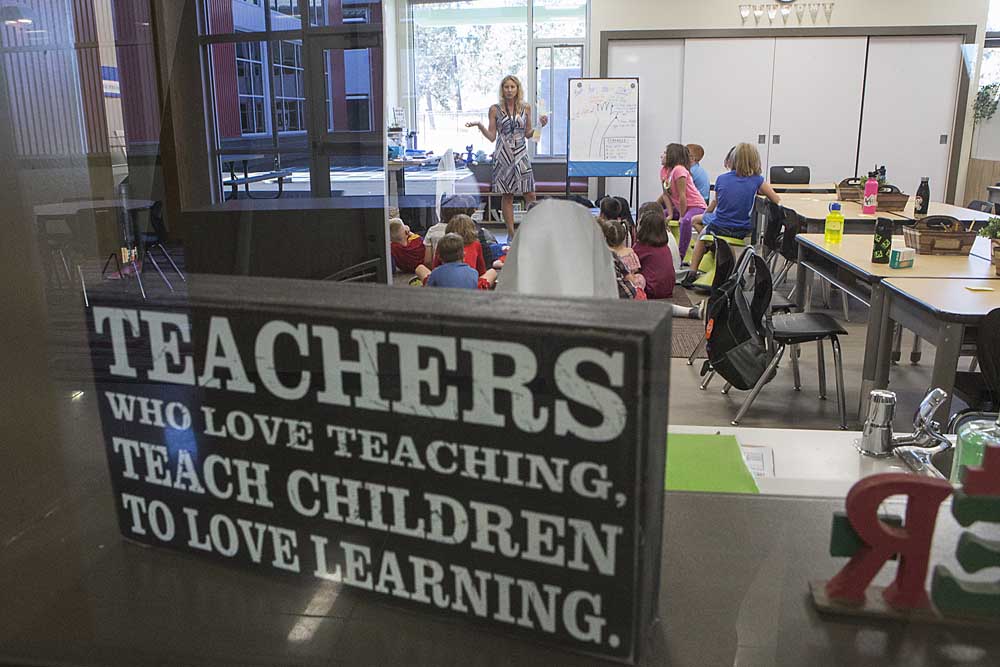Oregon to school districts: Plan for months of distance learning
Published 10:45 am Tuesday, March 31, 2020

- In this September 2019 file photo, Rebecca Larkin talks about an art project with her third grade class during the first day of classes at North Star Elementary School
The Oregon Department of Education issued guidelines late Monday for the state’s public schools to adopt distance learning strategies as officials anticipate Gov. Kate Brown’s stay-home orders may extend until the summer.
State schools chief Colt Gill told superintendents he anticipates “the strong possibility that our students may not come back through our school house doors this academic year.”
Districts should implement their distance learning plans by April 13, Gill said. Throughout the education department’s guidance for local districts, officials urge that plans will be a work-in-progress as many teachers sail into uncharted waters.
Local districts will spend the next two weeks developing their plans and tweak them as necessary after launching them in mid-April.
State officials launched a resource page for teachers and families, acknowledging sustained school closures put “additional pressure on families to juggle many responsibilities.” Oregon education officials call parents and caregivers “critical partners and co-facilitators of learning” in their guidance documents.
The state’s resource pages include supplemental lessons, tips on keeping kids engaged and sample schedules to keep children on track throughout the day.
Education officials say kindergartners and first graders should have no more than about two hours and 45 minutes of instruction per day — about 45 minutes of which should be teacher-led. Second and third graders should get about three hours and fourth and fifth graders get 31/2 with the first 60 and 90 minutes led by their teacher, respectively.
Middle and high school students should get three hours of teacher-led instruction every day totaling no more than 30 minutes per subject with an additional one or two hours of supplemental learning.
State officials also stress that students should take at least two hours per day for “brain breaks” and meals.
The education department also issued murkier guidelines on how to educate students for whom English is a second language and to keep the state’s talented and gifted students on track.
The state resource page for bilingual and emerging English speakers was not live Tuesday morning. State guidance directs educators to assess students’ English proficiency and work with families to identify what supports they might need.
For gifted students, teachers are instructed to focus on academic acceleration and lesson compacting.
The guidelines Gill’s office issued are an about-face from the stance state and local education officials took earlier this month, when they said the governor’s school closure order wouldn’t lead to online classes replacing the traditional classroom experience for Oregon students.
Then, as now, state and local education officials maintained that online instruction can’t fully replace the in-person classroom experience.
Officials said they faced considerable hurdles in providing accessible and equitable online education to the state’s approximate 640,000 public schools students, particularly those who speak English as a second language, students who lack computers or internet access and others with special circumstances during the shutdown.
Any educational material — including online instruction — would be supplemental and not intended to keep kids on the learning tracks they began at the outset of the academic year, officials said.
But that was when schools were meant to be shuttered for six weeks. In his memo, Gill writes the potential for a longer closure necessitated new guidance. And lessons are now expected to advance kids through their traditional tracks as closely as possible, although they won’t be for credit.
In many states, including Arizona, New Mexico and Oklahoma, coronavirus concerns have public schools shuttered for the rest of the academic year.
“We started with the idea that our children would miss a few days of school and that some days might be made up in the summer — something that is normal in Oregon which regularly encounters snow days and forest fires that close schools for a few days each year,” he said.
State officials did not address any plan or timeline of how — or when — schools will reopen to students once the governor’s stay-home order is lifted.






